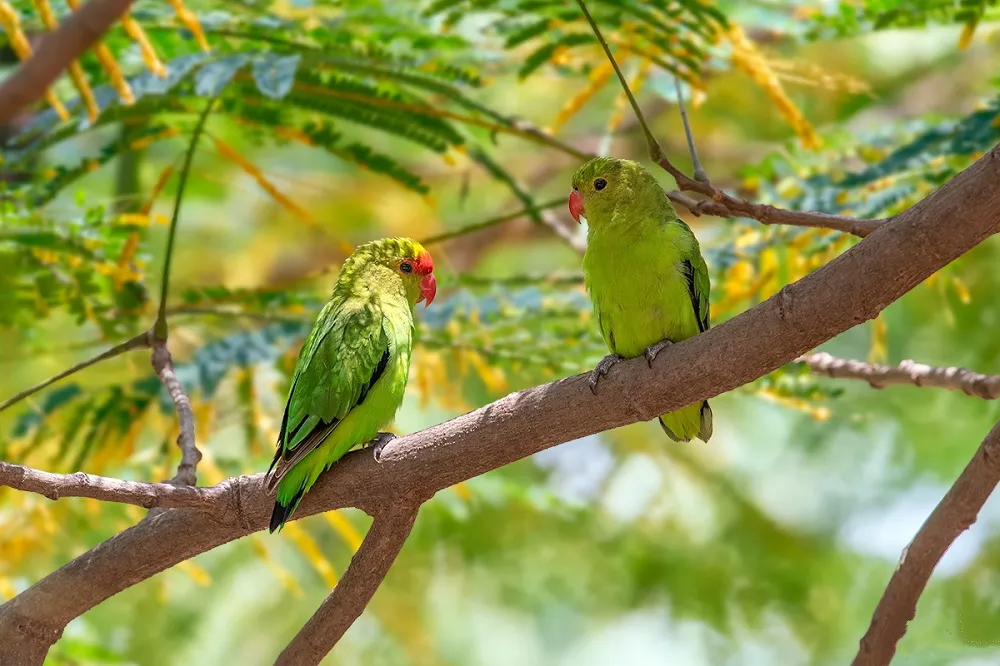The black-winged lovebird (Agapornis taranta) also known as Abyssinian lovebird is a mainly green bird of the parrot family. At about 16.5 cm (6.5 inches) long, it is the largest of the lovebird genus, a group of small parrots. The adult male is easily identified by its red forehead, and the adult female by its all-green head. They are native to Eritrea and Ethiopia, and they are uncommon as pets.
What does Black-winged lovebird look like
The male black-winged lovebird is dark green, with deep red feathers on the forehead, between the beak and the eyes, and around the eyes; the chest, abdomen, and inner wing coverts are light green; the inner wing coverts and flight feathers are black; the tail is Green; beak red; iris dark brown.
There is no red on the head and eyes of the female bird, and the lower wing feathers are green, with some green in the rest of the black.
The color of the young bird is similar to that of the female bird, but the body color is darker, and the beak is yellowish brown on a black background. It will not gradually begin to change into the color of the adult bird until 3 or 4 months old, and it will fully grow into a bird-like body. Body color takes 8-18 months.
Black-winged lovebird habitat
It mainly inhabits forest highlands, preferring juniper, albizia and euphorbia; the tropical grassland between 1800-3200 meters is also their active area. Wild species live in tropical jungles.
Black-winged lovebird living habit
They usually form a group of 8-20 individuals, and will gather many groups near the trees they inhabit; they prefer taller trees, and usually fly to the foraging area at dawn to search for food, and then arrive at the tree hole one hour before sunset , and then stay in the same dead tree hole all night, several birds will watch each other together.
Sometimes it lives in large groups, usually nests and reproduces in tree holes, and feeds on various plant seeds, fruits and berries (figs are preferred). Often clusters endanger crops and orchards.
Distribution area of Black-winged lovebird
Distributed in Eritrea and Ethiopia, it belongs to the plateau birds from Ethiopia.
Mode of reproduction
Black-winged lovebirds can breed in all seasons of the year except the hot summer. Generally, each female lays 6-8 eggs, and the incubation period is about 19 days. During the hatching process, the male bird stays outside the nest to take care of and feed the female bird, while the female bird always insists on hatching except when going out for food, drinking and defecation. After hatching, the chicks are fed by their parents. They can leave the nest in 35-40 days, live independently in about 50 days, and reach sexual maturity in 6 and a half months.
Black-winged lovebirds can be raised in pairs or in groups. The activity space of breeding birds shall not be less than 0.5 cubic meters. The bird cage needs to be made with No. 12 lead wire, and the diameter of the mesh should not exceed 2 cm to prevent the bird from getting out and flying away. The bottom of the cage should be covered with fine sand, and the feces should be cleaned up in time to keep the cage clean. If you raise a pair of black-winged lovebirds for artificial breeding, you can make a breeding cage with a size of 70 cm x 60 cm x 50 cm, and put an artificial nest box with a size of 20 cm x 16 cm x 16 cm inside. There is a circular entrance and exit of 5 cm, and a wooden platform is set under the mouth for the birds to step on when entering and exiting.
The feed of the black-winged lovebird is rice, millet, chestnut, millet, etc. In order to increase the nutritional content of the feed, 10% pockmark or sunflower seeds, oyster powder, green vegetables and fruits should be added. Daily weeds, rice, and millet can be mixed and fed in a ratio of 3:2:2.


 Facebook
Facebook  Instagram
Instagram  Youtube
Youtube 